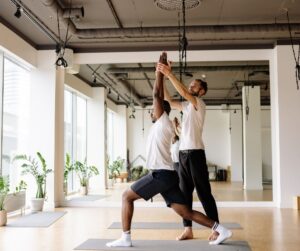In the fitness world, few topics have sparked as much debate as the effectiveness and application of stretching. For weekend warriors to elite athletes, the quest for optimal performance and injury prevention has often led to conflicting advice about warm up and cool down routines. Today, we’re dissecting the myths and facts surrounding stretching to empower you with a deeper understanding and a customized approach to enhancing your fitness regimen.
A Closer Look
Stretching, in its many forms, is a foundational element of physical activity. Still, misconceptions abound, leading to widespread debate about its utility and execution. Here’s what you need to know about static and dynamic stretching:

Static Stretching
- Definition: Extending a muscle to its fullest length and holding the position.
- Applications: Best used post-exercise for increasing flexibility and aiding recovery.
- Biomechanical Impact: Improves connective tissue elasticity, potentially reducing injury risk.

Dynamic Stretching
- Definition: Making controlled, active movements that stretch the muscles to their full range of motion
- Benefits: Enhances immediate performance and effectively warms up muscles by mirroring the activity to come.
- Recommendation: Ideal before exercises, a safer method to prep the body for dynamic actions.

Ed Middleton, Physiotherapist
Demystifying Common Myths
Myth 1: The Ultimate Injury Preventive Measure
Contrary to popular belief, the role of stretching in injury prevention is nuanced. While it can be beneficial, its effectiveness depends on the activity, the type of stretches performed, and an individual’s fitness level. Blanket statements about its efficacy overlook the complexity of human biomechanics and the specificity of sports demands.
Myth 2: All Stretching is Equally Beneficial
The reality is that stretching needs to be purposeful. Aimless stretching without a clear goal—improving flexibility, enhancing performance, or facilitating recovery—is unlikely to yield significant benefits. Your unique physical requirements and fitness objectives should inform how, when, and why you stretch.
Myth 3: One-Size-Fits-All in Warm-Ups and Cool-Downs
This notion fails to account for individual variances in physiology and fitness goals. For example, a gymnast may gain from prolonged static stretches to enhance muscle length. At the same time, a sprinter might prioritize dynamic stretches to maintain muscle responsiveness. The key is aligning your stretching routine with your activity profile and personal needs.

The Case for a Customized Approach
Acknowledging the pivotal role of customization underscores the crux of our discussion. A tailored stretching regimen, attuned to your specific physical attributes and aspirations, is the most effective strategy for leveraging stretching’s benefits. This approach encompasses the selection of appropriate stretches and the integration of strength and stability exercises to bolster overall mobility and performance.
Why Professional Guidance Matters
Given the evolving landscape of stretching research, professional insight is invaluable. Specialists like kinesiologists, physiotherapists, and chiropractors can demystify the complexities of stretching, offering tailored recommendations that resonate with your physiological profile and fitness targets.

The Power of Personalization
The stretching debate ultimately reveals a broader truth about fitness: any regimen must be personalized to realize maximum effectiveness. By considering the latest science, acknowledging individual differences, and opting for informed, specialized guidance, athletes and fitness enthusiasts alike can unlock stretching’s true potential—enhancing flexibility, performance, and overall well-being on their terms.
In conclusion, as we unravel the myths surrounding stretching and move towards a more nuanced understanding, the role of informed, personalized strategies becomes clear. Incorporating stretching into your fitness regimen should not follow a cookie-cutter approach but rather a thoughtful, individualized plan that acknowledges your body’s unique needs and the demands of your chosen activities. To get started on a personalized plan, book your initial assessment today.
Written by: DeVera Nybo, MBA, Owner Newleaf Total Wellness Centre.

